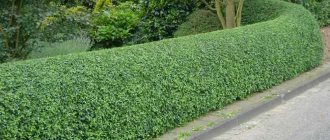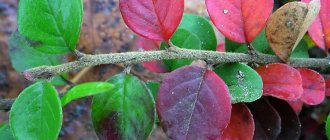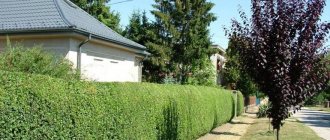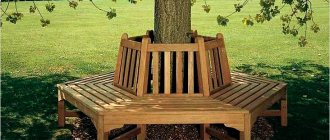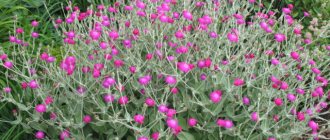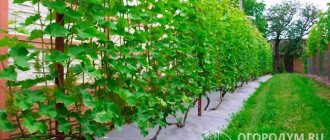The desire to fence off one's territory, to hide from prying eyes, intruders, stray animals, or to provide a barrier from the wind is inherent in most landowners.
One of the most successful options is a hedge. It not only protects from unwanted guests, extraneous noise and street dust, but also decorates the area. Due to its properties, cotoneaster has been used for a long time. This shrub forms a dense and attractive medium-height barrier that provides good protection and requires little maintenance.
Description of cotoneaster
The brilliant cotoneaster grows wild in the northern provinces of China and southern Siberia. I love rocky slopes and pebble deposits along river banks. The plant is very unpretentious, so dogwood bushes are convenient to use for hedges.
From bright cotoneaster bushes you can create a three-meter hedge. The crown of an independent bush can exceed its height by one and a half times, so the hedge will have to be trimmed regularly.
The brilliant dark green flowers have a yellowish underside and change color to reddish brown in the fall. At the end of spring or early summer, bright cotoneaster is covered with pink inflorescences. They wrap themselves so tightly around the shoots that the foliage is almost invisible to them. In mid-autumn, bright fruits with a diameter of 7-9 cm ripen.
Varieties of bright dogwoods suitable for hedges:
Common cotoneaster. The most frost-resistant and unpretentious variety. Suitable for central Russia.
A beautiful coral hybrid. A low shrub up to half a meter high and two to three times wider. It is distinguished by white inflorescences and coral-colored berries.
Black cotoneaster. Grows up to 2.5 m, the foliage is dull. Tolerates low temperatures well.
Evergreen cotoneaster. Grows up to 2 m in height. The foliage is silvery-green, the berries are orange, with crimson highlights.
There are several low-growing varieties that should not be used to create a hedge: horizontal cotoneaster, creeping cotoneaster, pressed cotoneaster, dwarf cotoneaster. These species are best suited for decorative borders or lawn decorations.
Important! Dogwood is different from the bright cotoneaster. The berries of the first type are used for food, but the second type are not edible.
Pest and disease control
The brilliant cotoneaster is often affected by fusarium, which is a fungal disease. When infected, the leaves begin to yellow and fall, and flowering is inhibited.
In the absence of timely treatment, plants quickly die. Therefore, when a disease is detected, you must immediately remove the affected areas and treat the bush and soil with a fungicide.
Among the pests that can settle on cotoneaster are aphids, apple moths, sawflies, scale insects, spider mites and yellow bears. They are combated with the help of insecticides.
If the infection is at the very beginning, then you can use traditional methods of treatment. For this purpose, spraying with tincture of garlic, a decoction of wormwood, yarrow or infusion of potato tops is suitable.
Pros and cons of cotoneaster hedges
A green fence made of bright cotoneaster can withstand any conditions: lack of sun and moisture, poor soil, severe air pollution near the road. Even unsuccessful pruning will only spoil the decorative effect and the nerves of the owners, but will not cause significant damage to the plant.
Bright cotoneaster remains decorative even in autumn. Its foliage is painted in incredibly beautiful shades of yellow, crimson, and red. And black fruits are stored until frost.
Cotoneaster blooms brilliantly for a whole month. And all this time the hedge will fill the area with a pleasant aroma. True, not only people like this smell. The bees hear this from afar and rush to the brilliant blooming cotoneaster.
A bright hedge of cotoneaster has strong immunity. However, sometimes he is attacked by parasites. The brilliant cotoneaster is afraid:
- apple aphid;
- shield;
- dogwood mite;
- plum saw.
Insects are destroyed using medicinal herbs or insecticides. Bright cotoneaster is susceptible to powdery mildew and fusarium. Disinfection of the soil, complete pruning of diseased shoots and burning them will be required. After pruning the affected areas, they are treated with a fungicide.
Advantages and disadvantages
Cotoneaster brilliant has a number of advantages, which significantly increases its chances of being chosen by gardeners. And not only as a hedge. Craftsmen often carve various abstractions and figures from pliable plants.
In addition, the plant:
- calmly tolerates temperature changes, high and low readings;
- unpretentious to soil structure;
- tolerates drought well;
- has a low risk of diseases and pests;
- undemanding to lighting, which allows you to grow it in any area of the garden.
But when choosing, you should take into account some disadvantages:
- the need to regularly trim the bush;
- some difficulties in the process of reproduction.
Based on reviews from gardeners, we can conclude that cotoneaster looks great as a hedge even without regular pruning.
Fence location options
Bright cotoneaster loves the sun, but will grow well in a shady place. If rapid growth of the bush is required, you should choose well-lit places. There the plant will quickly take on a good shape.
In a hedge of bright cotoneaster you can place:
- along the external boundaries of the site;
- on rails;
- cover appendages from eyes;
- fence off a resting place;
- complete a layered composition of flowers and climbing plants;
- serve as a bright green fence for a flower bed
There are no thorns on the branches of the brilliant cotoneaster. This slightly worsens its protective functions, but reduces the risk of injury when caring for the bush. The danger can arise only during the flowering period, when the hedges will be visited en masse by bees flying from all over the area.
Landing Features
The shrub takes a change of place calmly, tolerates replanting almost painlessly and adapts to the new soil. However, it’s not worth the risk and it’s better to wait to transplant or plant until spring and the soil warms up.
The bush is calm about changing places
Site selection and soil preparation
Although cotoneaster does not require lighting, it is recommended to choose a well-lit place for planting. Light shading will not be a hindrance, but constant shade will not allow the bush to grow luxuriantly. The plant does not tolerate drafts and strong gusts of wind, so it is better to choose a cozy, protected place.
Since the depth of the hole must be at least 50 cm, you also need to focus on the depth of groundwater deposits. But in any case, it is better to place a drainage layer on the bottom of the hole.
The composition of the soil does not play a decisive role, but properly fertilized soil will provide the shrub with all the necessary nutrients for growth and development.
The soil is prepared from the following components: turf soil, peat or compost and coarse sand. Turf soil and sand are mixed in equal quantities, and peat should make up only ½ of any of these ingredients.
It would also be advisable to add lime at the rate of 300 g per 1 m².
General landing rules
- The planting period depends on the type of seedlings: if the seedlings have closed roots, then they can be planted from early spring until late autumn. If the roots are open - end of March and April or September and October.
- Number of bushes per 1 m² (depending on the purpose of planting): for a high hedge – up to 3, for a low hedge – 4–5. The chess order assumes a distance of 40–50 cm.
- The pit should be from half a meter to 70 cm deep and of a similar width.
- A layer of drainage is laid at the bottom of the pit: broken brick, pebbles, gravel.
How to plant brilliant cotoneaster for a hedge
You can make a hedge from bright cotoneaster bushes using:
- seeds;
- cuttings;
- separation;
- layering.
All these methods require time, skill and hassle. Cotoneaster seeds do not germinate well. They are collected from ripe berries. The fruits are dried in the open air, the seeds are removed and washed with water. These floating seeds need to be thrown away: they are “dummies”. Good seeds remain in water. Then they are dried, covered with a mixture of peat and sand and placed in the refrigerator.
it is much easier to create a hedge from 10-15 cm cuttings. At the beginning of summer, when pruning bright cotoneaster, young strong branches with two “knots” are cut off. If cuttings are prepared in the fall, you can use old and already hard branches, but then the number of “nodes” is increased to three. In the spring, the cuttings are treated with a special solution to stimulate growth and planted in sandy peat soil to a depth of five centimeters in a greenhouse.
The layers are formed by young shoots of bright cotoneaster. Most often, this method is used for low-growing or creeping shrubs. You need to select a healthy sprout, lay it on the ground and carefully secure it with a paper clip, hook, or wooden sling. Next season, carefully cut the branch at the base of the mother plant and replant the cuttings.
To plant a bright cotoneaster by division, you will need to carefully dig up the bush and divide it into several separate parts with a knife. Then the resulting new plants are immediately planted in the place of the future hedge.
Calculation of the number of seedlings
The recommended distance between light cotoneaster seedlings is about 50 cm, this is the required minimum. The maximum radius of action is -2 M. You can plant bushes less often, but the result will not look much like a hedge. Rather, it will turn out to be a series of independent bushes.
Before determining the required number of bright cotoneaster seedlings, choose a planting site and measure the length of the future hedge. Divide the result by 0.5 M. This will be the maximum number of seedlings. If the place is well lit all day, the shiny cotoneaster will grow well. Thus, the gap between the bushes can be increased without fear, that is, fewer seedlings will be required.
Site and soil preparation
Before you plant a shiny cotoneaster hedge, you need to choose the right location and prepare the soil. The plant loves bright sunlight or slightly shaded areas. It is not necessary to prepare the ground for the entire area of the future hedge. The base soil can be anything, since the nutrient mixture is placed directly into the holes prepared for planting seedlings.
Rules for planting bright cotoneaster to create a hedge:
- dig a hole about half a meter deep and the same diameter;
- pour crushed stone or brick shavings into it in a layer of about 20 cm;
- add soil from turf, peat, humus and sand in a ratio of 2: 1: 1: 1;
- lower the plant into the hole;
- make sure that the root collar is at ground level;
- digging, soil compaction, watering.
You can (but not necessarily) add lime to the planting mixture. Approximately 200-300 g of lime will be needed per 1 sq.m of land. After planting, a small area around the roots is sprinkled with peat to protect and enrich it with microelements.
Important! For ease of planting, bright cotoneasters are not planted in separate holes, but in a hole of the required depth, dug at the site of the future hedge.
Disembarkation dates
With the onset of warmth, when the soil has already thawed and buds have not yet appeared on the trees, you can begin planting seedlings. Most varieties are planted at this time, but the bright chokeberry cotoneaster takes root well when planted in autumn. The period from the fall of leaves to the appearance of the first frost is suitable for autumn sowing.
As a rule, ready-made potted seedlings are planted at the beginning of the season. They can also be planted in the summer, since the root system is already well formed and the plant can easily tolerate replanting.
Important! For late autumn planting, it is necessary to complete the work as quickly as possible so that the bright cotoneaster has time to take root well before the onset of frost.
Planting scheme
If a tall thin hedge is planned, glossy cotoneaster is planted in one row. To create a wide and dense border, the seedlings are arranged in two rows in a checkerboard pattern. In this case, there are about 4 shoots per linear meter.
It is not recommended to plant a triple row of cotoneaster bushes. The central part will be inaccessible for inspection and treatment, which can lead to damage by pests and diseases. Also, less sun reaches plants in the middle of the row (the sides are covered by neighboring bushes), which can slow down the growth of the hedge.
Important! When forming a future hedge, it is necessary to take into account the growth of the crown. The distance between cotoneaster bushes in a hedge should be from 0.5 to 2 m.
Reproduction
You can grow cotoneaster, which will create a high-quality hedge, with the help of proper propagation. The shrub propagates by layering, cuttings and fruit seeds. Gardeners rarely use the latter option, since seed germination is not very good, usually amounting to no more than 50% of the total amount of seed.
Propagation by cuttings is carried out in the summer, starting in mid-July. To do this, green cuttings are planted in a mixture of peat and sand. When they take root, the cuttings are transplanted and then covered with film to create a greenhouse effect.
Caring for a cotoneaster hedge
The plant does not require special care. The bushes will need to be pruned to remove old and diseased branches and to maintain the width of the hedge against the shiny cotoneaster. It is also necessary to loosen the root soil and water it from time to time in case of drought. In winter, no maintenance is usually required. You can cover the plantings with spruce branches or branches from severe frosts, but this is true for low-growing and creeping varieties.
Young cotoneaster bushes will require regular weeding and weeding. Over time, the overgrown crowns will shade the root soil, completely blocking the sun from the weeds.
When to trim cotoneaster for hedges
The cotoneaster hedge is trimmed in the spring, before the buds appear. This will not harm the plant, will rejuvenate it and allow it to form the crown of the desired configuration. The vibrant cotoneaster is not afraid of too much pruning. Calmly tolerates pruning last year's shoots to a third of their growth. Pruning tools should be very sharp to minimize damage to the plant.
Sanitary pruning can be done at any time. Dead, old or diseased branches must be removed. If the young growth is too thick for a hedge, it can also be trimmed during sanitary pruning.
Important! After pruning diseased branches, tools should be rinsed well or wiped with alcohol to prevent transmission of infection during subsequent use.
Watering
The natural conditions for growing brilliant cotoneaster are quite harsh. Does not require abundant watering. If the summer is wet enough, there is no need to water the hedge. If not a single rain has fallen during the entire hot period, the bush will need to be watered at approximately two-week intervals. Each adult bush will require 7-8 buckets of water. After rain or watering, it is necessary to check the condition of the soil around the bushes, remove all weeds and slightly loosen them to a depth of 15 cm.
Usually the main purpose of watering a hedge is not to moisten the soil, but to rinse the foliage so that it becomes bright and shiny again. This is especially true for bushes separating the area from the roadway with heavy traffic. Cleaning your fence hose with a shower head removes dust, dirt, grime and improves the appearance of your fence.
Important! Glossy cotoneaster does not like soil around its roots that is too wet.
Top dressing
It is recommended to fertilize at the beginning of the spring season. You will need urea or other mineral fertilizers at the rate of one tablespoon per 10 liters of water. It is optimal to feed each bush separately, watering the soil around the roots. If the planting is too dense, you can simply apply fertilizer along the hedge, as close to the roots of the bushes as possible.
Fertilizing can be repeated approximately in the second decade of May, before flowering begins. You can add superphosphate (60 g per m2) and potassium sulfate (10 g per m2) to the mixture.
How to propagate an ornamental shrub
The most convenient way is to plant annuals, but you can propagate the bush in other ways.
Seeds
To obtain seeds, the fruits must be freed from pulp and dried. Then collect the seeds, which must first be soaked in water before planting. Those that float to the surface are unsuitable for landing. Sow seeds at a distance of 15 cm, depth - 4 cm. Germination can take about a year.
After germination, it will take another year for the seedling to grow to 30 cm.
By layering
Long shoots that hang almost to the ground (10 cm) can be bent to the ground and pinned. Then the plant is covered with fertile soil. When the cuttings take root, you can cut off the shoot from the main bush.
Cuttings
Healthy shoots, from 15 cm long with several internodes, are excellent as cuttings. The cuttings are first placed in a solution of a growth stimulator, and then planted in the soil mixture at an angle of 45°. Then the cutting is covered with a glass container, which is removed daily to ventilate the seedling. After rooting, the cuttings are planted in a permanent place.
Cotoneaster grown from cuttings
How quickly does a cotoneaster hedge grow?
Building a regular fence is much faster than building a hedge. This process can be accelerated a little by planting young, but already well-formed bushes. But they will cost much more than seedlings.
After planting, bright cotoneaster bushes are left untouched for two years. Only after they grow a little do they begin to form a hedge. The first step is cutting to height. This will lead to rapid growth of side shoots.
Once the width of the hedge is sufficient, the growth of the sides is limited. First, you should pin the shoots to enhance tillering. However, shoots that extend beyond the intended contour are cut off.
Important! Showy cotoneaster will add a pop of color to fall foliage in sandy soil. Clay soil does not contain the elements necessary for this.
Table 1.1 - Description of the type
How does it grow? | The brilliant cotoneaster grows straight, reaching a height of 1.1 to 3 meters, has a very dense crown, which is formed by straight branches growing in all directions with multiple lateral shoots. |
| The leathery leaves are dark green in color and have a dense structure and gloss on the outer surface. This gave the species the name “brilliant”. On the reverse side, the leaf is yellow in color and has a small fluff in the first phases of development, which is gradually lost. With the arrival of autumn, the shiny foliage turns into dark shades from reddish-yellow to burgundy. In October, the colorful leaves fall. | |
Bush flowering | Flowering is observed on loose inflorescences, represented by corymbose tassels, on which 5-12 small pinkish flowers are formed. Flowering is observed from mid-May or in the first ten days of June, lasting for 30-40 days |
Fruiting | In autumn, brilliant cotoneaster is decorated with berries (from 0.7 to 0.9 cm), which have a spherical shape. Their surface is shiny, the skin is black, the flesh is reddish-brown with 2 or 3 seeds. Technical maturity begins in late September. The fruits remain on the branches almost until the first frost. The fruits are edible, but have virtually no taste. The first berries can be obtained in the 4th year after planting the seedling |
The culture is an excellent honey plant, the same as raspberries and linden. Flowers produce a lot of nectar, which attracts a large number of pollinating insects.
The brilliant cotoneaster is a long-liver, growing in one place for 50 years!
Due to its high decorative value and ease of care, the plant is very popular among landscape designers, owners of suburban and summer cottages, as well as city residents.
Reviews of hedges made of brilliant cotoneaster
Anastasia Pravysheva, 36 years old, Aleksandrovsk Cotoneaster Diamond grows slowly. We planted him a long time ago, but he is still small. Let's handle it the right way. We have a fence. I would like to grow up faster. We always prune it in April. Tatyana Krasko, 42 years old, Plavsk We have a landscape design of evergreen cotoneaster, spiral schneider and other evergreens. As they say, summer is here all year round, even under the snow, if you shake it off the plants. I also want to plant cotoneaster as a ground cover. Olga Petrovna Markova, 57 years old, Sovetsk Still a small bush. In the spring we trim and shape. We have a few shiny bushes, just a couple in the landscape. And not at all extravagant. You can also not water for several weeks.
What is Brilliant? Its varieties and types
Shrubs of the genus Cotoneaster belong to the Rosaceae family. There are about 100 species of representatives of this genus.
- Such shrubs are evergreen, their leaves are medium-sized with solid edges of a simple shape, which become reddish in autumn.
- It blooms with pink or white small flowers that can be collected in clusters or grow individually.
- This plant also has fruits - berries that are shaped like apples and are red or black in color.
Lucidus
Brilliant has another name - lucidus. It usually grows in the harsh conditions of the Transbaikal region. Lucidus is protected by the Red Book.
It is a shrub whose height reaches two meters.
- The leaves of this plant fall off.
- Lucidus has a thick, elongated crown, densely covered with leaves.
- It blooms throughout May, its flowers are small in size and pink in color. An inflorescence can contain from 5 to 12 flowers (as in the photo)
- The berries of the bush are similar to black rowan, but they cannot be eaten. They ripen in the fall and do not fall off for a long time; they can last until spring.
Chokeberry
There is also a variety of this shrub called chokeberry cotoneaster. It looks a little like glitter.
- The difference is the matte large leaves.
- The height of such a dogwood bush can reach almost three meters.
- This plant is not afraid of winter frosts.
A chokeberry hedge is an ideal option for its use in garden design.
Dammera
- The height of an evergreen creeping shrub can reach up to 10 cm.
- The leaves of this shrub are oval-shaped and more leathery.
- This species is popular in European gardens because, as it grows, it creates a luxurious lawn (pictured).
- It tolerates wintering well under snow.
- The fruits of this shrub are bright red berries.
Lawn from Dummer
Spread
This is a shrub that grows up to a meter in height and has a dense crown.
- This species is considered rare.
- The leaves are round in shape, their size is up to 2 cm.
- Easy to cut. Looks ideal in compositions with coniferous plants.
- Also fits perfectly into the design of rocky gardens.
- It is also used to create borders.
- May freeze when it thaws.
Cotoneaster in landscape design
The brilliant cotoneaster looks decorative in the spring in a blooming state, in the summer with dark green shiny foliage and in the fall with black fruits hanging on the branches until spring.
It is widely used in green building, especially for hedges that are regularly trimmed. It is considered one of the most suitable shrubs for this in the southern and middle parts of the northern forest zone of Russia, the central part of the forest-steppe zone of the European part of Russia and the countries of the former USSR, and is suitable for planting in the southern taiga zone, forest-steppe and steppe zones of Siberia and the southern part of the Far East.
The brilliant cotoneaster blooms
The brilliant cotoneaster also looks good in groups, edges and undergrowth, in the background in a mixborder and in the border along a path; dwarf forms are good in rocky areas. It is quite gas-resistant, so it tolerates urban conditions well.
Withstands cutting and shaping perfectly. It can be used to cut shapes of various heights and configurations, which is why landscape architects like to use brilliant cotoneaster.
Shiny cotoneaster bush in autumn
Is it necessary to cover cotoneaster for the winter?
Despite the fact that cotoneaster is a fairly frost-resistant plant, in harsh winters it is still better to cover it. Dry foliage or peat are well suited for these purposes (a layer up to 6 cm thick is formed). Branches of bushes that are too tall need to be bent to the ground, which will help preserve the buds during frosts. When snow falls, you can additionally sprinkle the bushes with it.
As you can see, even taking into account all the nuances of care, growing brilliant cotoneaster will not create many problems, and with a little effort, you will get an original decor for your site.
Rules for trimming green hedges
The growth of branches of the plant occurs relatively slowly; the bushes need to be shaped only 2 times a year. Several cutting rules for brilliant cotoneaster:
- Pruning is done with a well-sharpened brush cutter or special scissors.
- Plants that reach 60 cm in height begin to form (in the 2nd year of the growing season).
- In the spring, sanitary pruning is carried out, removing damaged and thickening shoots. Remove the tops, which will enhance branching.
- Young stems are not shortened by more than a third.
- Every year the height of the hedge is increased by 5–10 cm, depending on the strength of growth.
Smooth surfaces are cut using a stretched cord as a guide. Complex contours are formed using templates made of wooden blocks or boards, which are installed directly around the bushes and trimmed around the perimeter.
Be sure to also read about the Buddleia David bush.
Forming a hedge can seem like a very labor-intensive task, accessible only to professional gardeners. But this is only at first glance. The creative process itself brings a lot of pleasure and can inspire you to create interesting and unusual garden objects. The brilliant cotoneaster is perfect for such experiments. This culture always responds gratefully to pruning and minimal care. Even in simple forms, the plant looks bright and fresh from early spring until frost.

